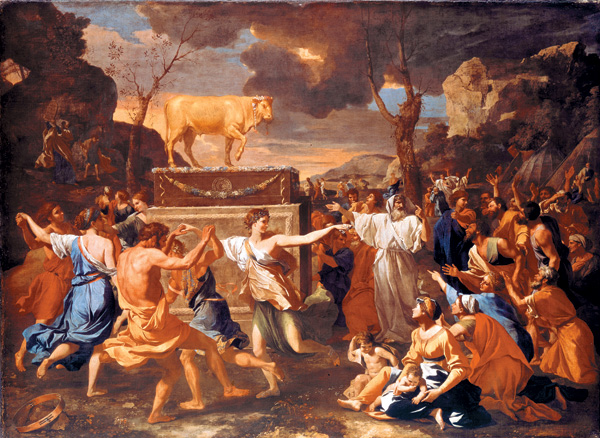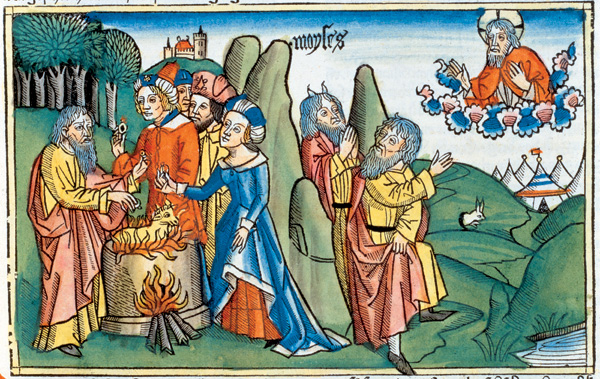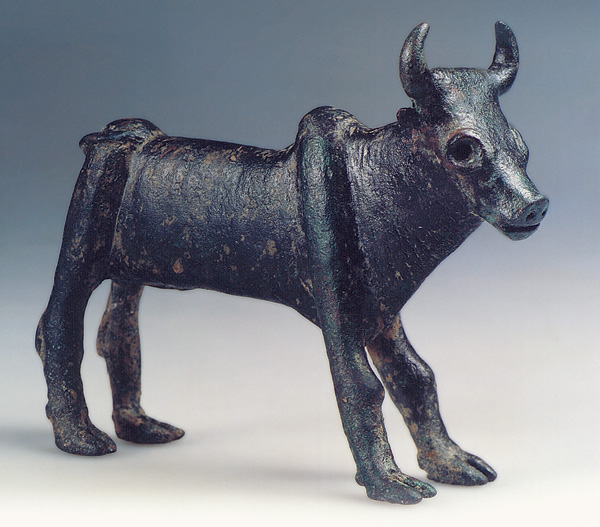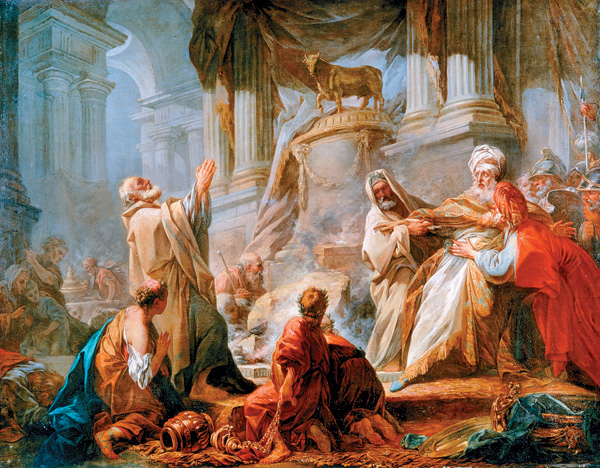
While Moses was up on Mt. Sinai receiving the first edition of the Ten Commandments, the people down below grew impatient and asked Aaron, Moses’ brother, to make them another god to lead them. Aaron instructed the people to rip off their gold earrings, which, the text tells us explicitly and unambiguously, “he made into a molten calf” (Exodus 32:4)—the famous Golden Calf. “These,” the people responded, “are your gods, O Israel, who brought you out of the land of Egypt!”
When Moses came down from the mountain and saw the Golden Calf, he became enraged and hurled the two tablets to the ground, smashing them to smithereens. And he burned the Golden Calf until it became a powder that he mixed with water, and then he made the wayward Israelites drink the resulting potion (Exodus 32:20), thereby calling attention to their infidelity (see Numbers 5:11–31).
Then he asked Aaron for an explanation. Why did he do it? Aaron replied, “Let my lord not be enraged … They said to me, ‘Make us a god to lead us; for that man Moses, who brought us from the land of Egypt—we do not know what happened to him.’ So I said to them, ‘Whoever has gold, rip it off.’ They gave it to me and I hurled it into the fire and out came this calf!” (Exodus 32:24).

Aaron’s response to Moses seems an outright lie. In the earlier telling (Exodus 32:4), the biblical narrator reported that Aaron had “made” the gold into a molten calf; he didn’t hurl it into the fire, only to see it magically transformed into a calf.
Not only is Aaron telling an outright lie, but the incredible event he claims occurred is also quite incomprehensible.
Some traditional Jewish exegetes, unhappy with Aaron seeming to be a liar, give credence to his response to Moses. For example, the great 11th-century commentator known as Rashi (short for Rabbi Solomon son of Isaac, of Troyes) tells us that Aaron’s explanation meant, “I didn’t know that this calf would come forth, but it came forth!” In other words, Aaron had nothing to do with it; he is exonerated. Rashi is here echoing various midrashima and legends which claimed that the calf was the work of the devil and that it did in fact come forth from the fire spontaneously.
One later legend even has it that the calf came forth alive.1 Another legend asserts that the calf came forth by itself, empowered by residual magic from an amulet that Moses himself had made to raise Joseph’s sunken coffin from the Nile, but had then left unused.2
I believe the key to understanding Aaron’s claim lies in understanding certain Mesopotamian texts concerning the idols as gods.

When a divine statue was sculpted in Mesopotamia, a so-called mouth-washing ritual was performed before the statue became the corporeal manifestation of the god itself—a living, anthropomorphic cult statue. The ritual assimilated the finite, physical image to the transcendent, intangible god, transforming the humanly manufactured icon into a living deity. Details about the mouth-washing ritual have already been described to BR readers.b Briefly, the mouth-washing ritual was a two-day event during which the cult statue was led by the incantation priest from the workshop where it was produced to a specially erected reed hut in an orchard by the riverbank; there it was ritually purified, enlivened and activated as a god. It was then escorted to its temple, where it was installed and honored as a living god. The actual washing of its mouth was believed to enliven the statue.
Cuneiform tablets contain different versions of the ritual, and scholars have explained it in different ways. Some see it as a kind of birthing process.3 Others see it as a kind of rite of passage.4 But in the different explanations and the different versions of the ritual and of the accompanying incantations, there is a common denominator: the idea that the divine statue is in fact a god created by gods and not by humans.
Numerous incantational pronouncements and rituals provide ideas about how the inert statue was thought to have become a god. Some pronouncements describe an autogenetic birth (a self-creation) in heaven. In others, the crafts-god Ea is said to be the statue’s father. On occasion, the wood from which the statue was made is said to have come from a holy forest. Sometimes the statue is said to have been manufactured by gods. A ritual instruction describes a ceremony in which the hands of the artisan who fashioned the statue are ritually cut off, as if to declare him not to be the sculptor. Finally, some tablets specifically deny the role of human artisans in the fabrication process.5
Thus, although the gods are born both in myth and in ritual, they seem to have created themselves. According to a Sumerian version, the statue is born in heaven and made on earth of itself—somewhat like Aaron’s explanation of the autogenesis of the Golden Calf. In another text, Sennacherib, king of Assyria, states that Anshar “made the statue of Anshar, king of all the great gods, creator of himself.” The manufacturing of the statue by the king and the skilled artisans is in fact a rehearsal for the mythological moment when Anshar creates himself.
It is as if the Mesopotamian idol makers were answering “no” to Jeremiah’s rhetorical question, “Can a man make gods for himself? No gods are they” (Jeremiah 16:20). The idol makers, too, recognized the impossibility of a man creating a god. However, rather than desisting from the attempt, the Mesopotamian idol makers claimed that they were not actually making a god, but the gods themselves were.
In the Golden Calf episode, first the narrator tells us what really happened, then Aaron tells Moses his very different version. Aaron, perhaps inspired by a Mesopotamian-like belief in the autogenesis of the divine statues, is invoking this as an exculpatory explanation to his brother: “I, Aaron, didn’t make the statue; it made itself.”
But perhaps there is something deeper. The narrator, by recounting first what really happened and then what Aaron says occurred, is signaling to the reader the spuriousness of the belief in autogenesis of divine statues. The narrator is really saying, “C’mon, Aaron, don’t be ridiculous; golden calves don’t just jump out of the fire.”c

This may reflect conditions in the seventh century B.C.E., when, some scholars say, this text was actually written. The northern kingdom of Israel had broken away and set up golden calves in their temples in Dan and Bethel to compete with the Jerusalem Temple in Judah. Perhaps the explanation Aaron gives to Moses was a mocking of claims the priests of the temples of Dan and Bethel may have made that their golden calves were divinely fabricated. The priests’ claims would have been as baseless as Aaron’s far-fetched explanation of how the Golden Calf happened to have been at the foot of the mountain to greet Moses on his return.
MLA Citation
Footnotes
Midrash (plural midrashim) is rabbinic lore of either a legal or nonlegal nature attached to a biblical verse.
Michael B. Dick, “Worshiping Idols: What Isaiah Didn’t Know,” BR, April 2002.
Endnotes
For synopsis and sources, see Louis Ginzberg, The Legends of the Jews (Philadelphia: Jewish Publication Society of America, 1911), vol. 3, p. 122; vol. 6, p. 51 n. 266.
Thorkild Jacobsen, “The Graven Image,” in Ancient Israelite Religion: Essays in Honor of Frank Moore Cross, ed. Patrick Miller et al. (Philadelphia: Fortress Press, 1987), pp. 15–32.
Angelika Berlejung, “Washing the Mouth: The Consecration of Divine Images in Mesopotamia,” in The Image and the Book: Iconic Cults, Aniconicism and the Rise of Book Religion in Israel and the Ancient Near East, ed. Karel van der Toorn (Leuven: Peeters, 1997), pp. 45–72.

